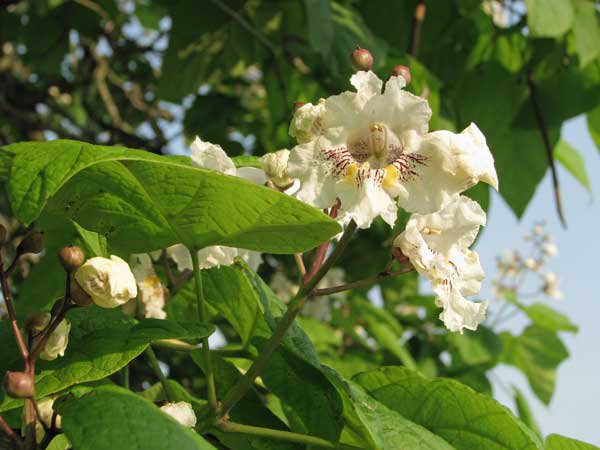| ||||||||||
Dr. Ronald P. Rogers CHIROPRACTOR Support for your body's natural healing capabilities 270-384-5554 Click here for details 


Columbia Gas Dept. GAS LEAK or GAS SMELL Contact Numbers 24 hrs/ 365 days 270-384-2006 or 9-1-1 Call before you dig Visit ColumbiaMagazine's Directory of Churches Addresses, times, phone numbers and more for churches in Adair County Find Great Stuff in ColumbiaMagazine's Classified Ads Antiques, Help Wanted, Autos, Real Estate, Legal Notices, More... 
|
Tom Chaney: R717 - The catalpa's white week Of writers and their books. Essay The Catalpa's White Week The next latest Tom Chaney column: Rumpole and the Primrose Path. A review of book by John Mortimer By Tom Chaney bookstore@scrtc.com "The Catalpa's White Week . . ."What a strange spring this is! Unusual heat followed by freezation. With memories of last April's ice storm fresh in mind, we held our breath through a warm March -- topping out at ninety. Maple leaves emerged tiny and green. Tickled into early bloom, the silly forsythia gave us gold for a while. Easter hope crystallized in ice. The maple trees again were stripped. Ice last April, cold this time. Forsythian gold ended in black frost. Shrubs in dooryards -- bleak and brown -- may not recover. We waited -- a tardy spring finally arrived with belated normality. I have been anxious about the town's old catalpa tree. Shivering there in the park, confronting destruction by fire and man's depredation, its white week seemed delayed. Relieved, we watched it slowly leave and hesitantly bloom. Catalpas are not much use. John Ciardi catches the essence of catalpa in his poem by that name. That tree's a nuisance, really. Long beforeBut this week our tree again "has its arms full of its own flowering now." A few days of bloom, then showers of white cascading down, swirling around the town's ruins. It stands -- despite fire and bulldozer -- trying to stem time's malediction. We have the catalpa for its one white pass . . .Each year at The Bookstore we post the complete poem by John Ciardi in our window through which one has a full view of the catalpa in its one white pass. Stop by. Read the poem as the annual beauty across the way fades -- framed by civic fire and man's cruel ruin. Tom Chaney can be found telling stories, planning his next meal, and occasionally selling books at THE BOOKSTORE Box 73 / 111 Water Street Horse Cave, Kentucky 42749. Phone (270) 786-3084. email: Tom Chaney bookstore@scrtc.com The BOOKSTORETo see links to other Tom Chaney essays and book reviews, enter "Tom Chaney" in the search box This story was posted on 2011-05-22 14:02:02
Printable: this page is now automatically formatted for printing.
Have comments or corrections for this story? Use our contact form and let us know.
More articles from topic Tom Chaney: Of Writers and Their Books:
Tom Chaney: Rumpole and the Primrose Path Tom Chaney: The Unseen Savage of the White Man's Heart Tom Chaney No. R709: War: sex, and money Tom Chaney: No. R708 Think Globally, Act Locally Tom Chaney: No. R707 Rising Tide on the Mississippi Tom Chaney: R706: Maybe as a poem Tom Chaney: No. R705: Willie Morris' Last Bugle Tom Chaney: No. R704. McKinney No. 1 - 400 barrels a day Tom Chaney: No. R703. Friday Night at the Strand Tom Chaney: No. R702. Remembering Cuba View even more articles in topic Tom Chaney: Of Writers and Their Books |



|
||||||||
|
| ||||||||||
|
Quick Links to Popular Features
Looking for a story or picture? Try our Photo Archive or our Stories Archive for all the information that's appeared on ColumbiaMagazine.com. | ||||||||||
|
Contact us: Columbia Magazine and columbiamagazine.com are published by Linda Waggener and Pen Waggener, PO Box 906, Columbia, KY 42728. Please use our contact page, or send questions about technical issues with this site to webmaster@columbiamagazine.com. All logos and trademarks used on this site are property of their respective owners. All comments remain the property and responsibility of their posters, all articles and photos remain the property of their creators, and all the rest is copyright 1995-Present by Columbia Magazine. Privacy policy: use of this site requires no sharing of information. Voluntarily shared information may be published and made available to the public on this site and/or stored electronically. Anonymous submissions will be subject to additional verification. Cookies are not required to use our site. However, if you have cookies enabled in your web browser, some of our advertisers may use cookies for interest-based advertising across multiple domains. For more information about third-party advertising, visit the NAI web privacy site.
| ||||||||||




















































